| French porcelain |
|---|
 |
|


Saint-Cloud porcelain was a type of soft-paste porcelain produced in the French town of Saint-Cloud from the late 17th to the mid 18th century.
| French porcelain |
|---|
 |
|


Saint-Cloud porcelain was a type of soft-paste porcelain produced in the French town of Saint-Cloud from the late 17th to the mid 18th century.
In 1702, Philippe I, Duke of Orléans gave letters-patent to the family of Pierre Chicaneau, who were said to have been making porcelain as "perfect as the Chinese" since 1693. [1] Chicaneau's factory was a pioneer in the manufacture of porcelain in Europe, where there had been many attempts to copy Chinese porcelain. Saint-Cloud developed a frit ("a mixture of a flux, sand and chalk") which was close, although not similar, to Asian porcelain. [2]
The porcelain produced in Saint-Cloud was influenced by late Ming blue and white porcelain and its motifs were based on Chinese originals. The typical underglaze blue painted Saint-Cloud porcelain, says W.B. Honey, "is one of the most distinct and attractive of porcelains, and not the least part of its charm lies in the quality of the material itself. It is rarely of a pure white, but the warm yellowish or ivory tone of the best wares of the period is sympathetic and by no means a shortcoming; and while actually very soft and glassy, it has a firm texture unlike any other. The glaze often shows a fine satin-like pitting of the surface that helps to distinguish it from the brilliant shiny glaze of Mennecy porcelain, which is otherwise similar. The heavy build of the pieces is also characteristic and is saved from clumsiness by a finer sense of mass, revealed in the subtly graduated thickness of wall and a delicate shaping of edges." [3]
Around 1722, Chicaneau's business passed through marriage to Henri Trou. After 1730, polychrome porcelain came to be produced, also in imitation of Chinese polychrome styles of porcelain, such as the "Famille rose" types. The Japanese Kakiemon style of Arita porcelain, Japan, known as "Fleurs indiennes" ("Flowers of the Indies") was also used as an inspiration.

In its later years, Saint-Cloud also produced various designs which were less Asian in character, especially with some white soft-paste porcelain wares. After 1752, Vincennes porcelain was handed a monopoly of polychrome decors, which reduced the scope of other manufactories to some degree. [4]
Production continued until 1766, when competition from the Chantilly and Vincennes porcelain manufactories put Saint-Cloud out of business. [1]

Porcelain is a ceramic material made by heating raw materials, generally including kaolinite, in a kiln to temperatures between 1,200 and 1,400 °C. The greater strength and translucence of porcelain, relative to other types of pottery, arise mainly from vitrification and the formation of the mineral mullite within the body at these high temperatures. End applications include tableware, decorative ware such as figurines, toilets and washbasins, and products in technology and industry such as electrical insulators and laboratory ware.

Imari ware is a Western term for a brightly-coloured style of Arita ware Japanese export porcelain made in the area of Arita, in the former Hizen Province, northwestern Kyūshū. They were exported to Europe in large quantities, especially between the second half of the 17th century and the first half of the 18th century.

The Vincennes porcelain manufactory was established in 1740 in the disused royal Château de Vincennes, in Vincennes, east of Paris, which was from the start the main market for its wares.

Kakiemon is a style of Japanese porcelain, with overglaze decoration called "enameled" ceramics. It was originally produced at the factories around Arita, in Japan's Hizen province from the Edo period's mid-17th century onwards. The quality of its decoration was highly prized in the West and widely imitated by major European porcelain manufacturers during the Rococo period.
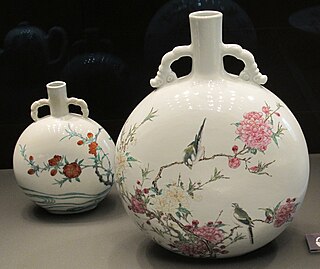
Famille jaune, noire, rose, verte are terms used in the West to classify Chinese porcelain of the Qing dynasty by the dominant colour of its enamel palette. These wares were initially grouped under the French names of famille verte, and famille rose by Albert Jacquemart in 1862. The other terms famille jaune (yellow) and famille noire (black) may have been introduced later by dealers or collectors and they are generally considered subcategories of famille verte. Famille verte porcelain was produced mainly during the Kangxi era, while famille rose porcelain was popular in the 18th and 19th century. Much of the Chinese production was Jingdezhen porcelain, and a large proportion were made for export to the West, but some of the finest were made for the Imperial court.

Famille rose is a type of Chinese porcelain introduced in the 18th century and defined by pink overglaze enamel. It is a Western classification for Qing dynasty porcelain known in Chinese by various terms: fencai, ruancai, yangcai, and falangcai. The colour palette is thought to have been brought to China during the reign of Kangxi (1654–1722) by Western Jesuits who worked at the palace, but perfected only in the Yongzheng era when the finest pieces were made, and famille rose ware reached the peak of its technical excellence during the Qianlong period.

Soft-paste porcelain is a type of ceramic material in pottery, usually accepted as a type of porcelain. It is weaker than "true" hard-paste porcelain, and does not require either its high firing temperatures or special mineral ingredients. There are many types, using a range of materials. The material originated in the attempts by many European potters to replicate hard-paste Chinese export porcelain, especially in the 18th century, and the best versions match hard-paste in whiteness and translucency, but not in strength. But the look and feel of the material can be highly attractive, and it can take painted decoration very well.
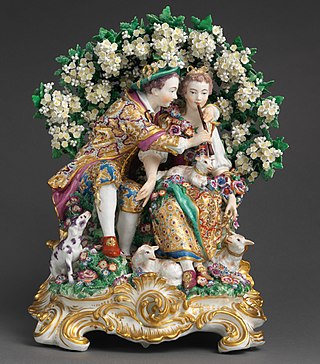
Chelsea porcelain is the porcelain made by the Chelsea porcelain manufactory, the first important porcelain manufactory in England, established around 1743–45, and operating independently until 1770, when it was merged with Derby porcelain. It made soft-paste porcelain throughout its history, though there were several changes in the "body" material and glaze used. Its wares were aimed at a luxury market, and its site in Chelsea, London, was close to the fashionable Ranelagh Gardens pleasure ground, opened in 1742.

Biscuit porcelain, bisque porcelain or bisque is unglazed, white porcelain treated as a final product, with a matte appearance and texture to the touch. It has been widely used in European pottery, mainly for sculptural and decorative objects that are not tableware and so do not need a glaze for protection.
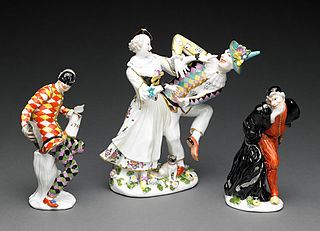
Meissen porcelain or Meissen china was the first European hard-paste porcelain. Early experiments were done in 1708 by Ehrenfried Walther von Tschirnhaus. After his death that October, Johann Friedrich Böttger continued von Tschirnhaus's work and brought this type of porcelain to the market, financed by Augustus the Strong, King of Poland and Elector of Saxony. The production of porcelain in the royal factory at Meissen, near Dresden, started in 1710 and attracted artists and artisans to establish, arguably, the most famous porcelain manufacturer known throughout the world. Its signature logo, the crossed swords, was introduced in 1720 to protect its production; the mark of the swords is reportedly one of the oldest trademarks in existence.

The Manufacture nationale de Sèvres is one of the principal European porcelain factories. It is located in Sèvres, Hauts-de-Seine, France. It is the continuation of Vincennes porcelain, founded in 1740, which moved to Sèvres in 1756. It has been owned by the French crown or government since 1759.
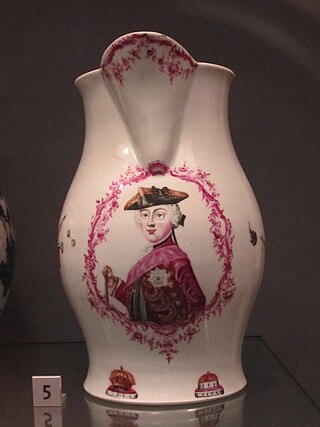
Liverpool porcelain is mostly of the soft-paste porcelain type and was produced between about 1754 and 1804 in various factories in Liverpool. Tin-glazed English delftware had been produced in Liverpool from at least 1710 at numerous potteries, but some then switched to making porcelain. A portion of the output was exported, mainly to North America and the Caribbean.

Bristol porcelain covers porcelain made in Bristol, England by several companies in the 18th and 19th centuries. The plain term "Bristol porcelain" is most likely to refer to the factory moved from Plymouth in 1770, the second Bristol factory. The product of the earliest factory is usually called Lund's Bristol ware and was made from about 1750 until 1752, when the operation was merged with Worcester porcelain; this was soft-paste porcelain.

The Bow porcelain factory was an emulative rival of the Chelsea porcelain factory in the manufacture of early soft-paste porcelain in Great Britain. The two London factories were the first in England. It was originally located near Bow, in what is now the London Borough of Tower Hamlets, but by 1749 it had moved to "New Canton", sited east of the River Lea, and then in Essex, now in the London Borough of Newham.
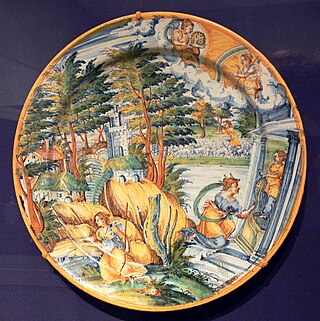
Tin-glazed pottery is earthenware covered in lead glaze with added tin oxide which is white, shiny and opaque ; usually this provides a background for brightly painted decoration. It has been important in Islamic and European pottery, but very little used in East Asia. The pottery body is usually made of red or buff-colored earthenware and the white glaze imitated Chinese porcelain. The decoration on tin-glazed pottery is usually applied to the unfired glaze surface by brush with metallic oxides, commonly cobalt oxide, copper oxide, iron oxide, manganese dioxide and antimony oxide. The makers of Italian tin-glazed pottery from the late Renaissance blended oxides to produce detailed and realistic polychrome paintings.

Chantilly porcelain is French soft-paste porcelain produced between 1730 and 1800 by the manufactory of Chantilly in Oise, France. The wares are usually divided into three periods, 1730–1751, 1751–1760, and a gradual decline from 1760 to 1800.

The city of Rouen, Normandy has been a centre for the production of faience or tin-glazed earthenware pottery, since at least the 1540s. Unlike Nevers faience, where the earliest potters were immigrants from Italy, who at first continued to make wares in Italian maiolica styles with Italian methods, Rouen faience was essentially French in inspiration, though later influenced by East Asian porcelain. As at Nevers, a number of styles were developed and several were made at the same periods.

French porcelain has a history spanning a period from the 17th century to the present. The French were heavily involved in the early European efforts to discover the secrets of making the hard-paste porcelain known from Chinese and Japanese export porcelain. They succeeded in developing soft-paste porcelain, but Meissen porcelain was the first to make true hard-paste, around 1710, and the French took over 50 years to catch up with Meissen and the other German factories.
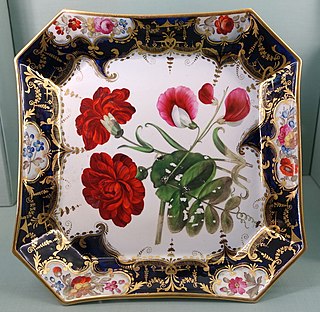
Coalport, Shropshire, England was a centre of porcelain and pottery production between about 1795 and 1926, with the Coalport porcelain brand continuing to be used up to the present. The opening in 1792 of the Coalport Canal, which joins the River Severn at Coalport, had increased the attractiveness of the site, and from 1800 until a merger in 1814 there were two factories operating, one on each side of the canal, making rather similar wares which are now often difficult to tell apart.

China painting, or porcelain painting, is the decoration of glazed porcelain objects such as plates, bowls, vases or statues. The body of the object may be hard-paste porcelain, developed in China in the 7th or 8th century, or soft-paste porcelain, developed in 18th-century Europe. The broader term ceramic painting includes painted decoration on lead-glazed earthenware such as creamware or tin-glazed pottery such as maiolica or faience.